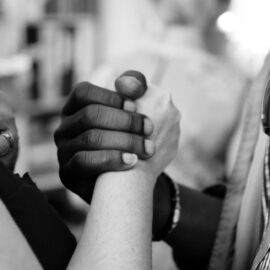

This article is an excerpt from the Shortform book guide to "Polysecure" by Jessica Fern. Shortform has the world's best summaries and analyses of books you should be reading.
Like this article? Sign up for a free trial here.
What is consensual non-monogamy? Is it the same as polyamory? Why are more people choosing relationships outside traditional monogamy?
Consensual non-monogamy encompasses various relationship structures where partners openly agree to maintain multiple romantic or sexual connections. From open relationships to polyamory, these arrangements strive for honest communication, clear boundaries, and mutual respect among all involved.
Keep reading to explore how this relationship model challenges traditional norms, promotes authenticity, and creates space for diverse expressions of intimacy.
Consensual Non-Monogamy
What is consensual non-monogamy? Psychologist Jessica Fern defines consensual non-monogamy (CNM) as a relationship model where people have multiple, consensual, and simultaneous romantic and/or sexual partnerships. Contrary to popular misconceptions, CNM isn’t cheating; instead, it’s a clearly agreed-upon arrangement that relies on honesty, communication, and compassionate consideration for everyone’s needs and boundaries.
(Shortform note: CNM and polyamory are often used interchangeably but describe different types of relationship structures and practices. Consensual non-monogamy, also sometimes called ethical non-monogamy (ENM), is a broad category that encompasses various relationship styles involving multiple romantic or sexual partners with the mutual consent of everyone involved. Polyamory is one type of CNM, where individuals have intimate relationships with more than one partner simultaneously. While polyamory is a form of CNM, it’s not the only one, as CNM also includes practices such as open relationships and swinging.)
Fern explains that CNM doesn’t look the same for everyone. It includes a wide spectrum of relationships, from those that maintain some level of sexual or emotional exclusivity to those that completely reject hierarchical relationship structures (where partners have varying degrees of importance).
(Shortform note: Research from the Kinsey Institute reveals that one in nine Americans have participated in relationship structures classified as consensual non-monogamy. Additionally, about one in six Americans express interest in polyamorous relationships, a figure comparable to the number of cat owners in the US. These statistics highlight that CNM is not as marginal a practice as some might assume.)
CNM has become less taboo. Fern points out that changes in society’s views on gender, sexuality, race, and family dynamics have increased the visibility and acceptance of CNM and other diverse relationship models. Yet, she notes that norms still tend to favor monogamy as the ideal relationship structure, often ignoring the drawbacks of monogamy and how it doesn’t meet everyone’s needs.
(Shortform note: The term “consensual non-monogamy” has gained traction in recent decades with increased acceptance of diverse relationship structures. However, the practices underlying CNM are far from new. Throughout history, various forms of non-monogamous relationships existed long before contemporary terminology emerged. For example, the Mosuo people of China practice the long-standing tradition of “walking marriages,” in which women have multiple consensual, non-monogamous relationships. Mosuo women have the autonomy to choose and change partners freely without the constraints of formal marriage, and children are raised within the maternal family structure.)
| The Evolution of Consensual Non-Monogamy in Media The portrayal of CNM in media has evolved significantly over the past few decades, reflecting a growing acceptance and understanding of diverse relationship models. In the 1970s and 1980s, portrayals were scarce and often limited to underground or art-house films such as Bob & Carol & Ted & Alice (1969), which often failed to capture the ethical aspects of CNM. The 1990s brought more diverse relationship structures, with The L Word (2004-2009) including polyamorous storylines, laying the groundwork for more explicit CNM representation.The 2010s marked a shift with shows like Polyamory: Married & Dating (2012-2013) on Showtime, offering a more authentic look at polyamorous lives. The trend continued in the 2010s with shows like You Me Her (2016-2020) and Wanderlust (2018), which contributed to the normalization and humanization of CNM. More recently, shows such as Sense8 (2015-2018) and Why Women Kill (2019-present) further illuminated CNM, emphasizing consent, communication, and emotional depth, and reflecting a more realistic and positive portrayal. Despite growing representation of polyamorous relationships, monogamy is still the norm in most popular media. |
Fern explains that people choose CNM for various reasons. For some, it offers emotional and sexual experiences that monogamous relationships can’t provide. For others, CNM challenges the patriarchal history of monogamy—marked by traditional gender roles, power dynamics, and economic dependence—allowing them to establish relationships that feel more equal and empowering.
| Are CNM Relationships Really More Equal and Empowering? While CNM challenges traditional relationship structures, people in CNM relationships can still grapple with many of the same challenges and potential power imbalances found in monogamous relationships. For example, one partner may end up handling the majority of the relationship’s communication and emotional work. Similarly, when setting boundaries or making decisions, one partner’s preferences may consistently take priority. While CNM places a strong emphasis on independence and open dialogue, CNM relationships aren’t inherently more egalitarian than monogamous relationships. This imbalance can also manifest in other ways. In Love’s Not Color Blind, Kevin Patterson notes that both monogamous and non-monogamous communities can mirror societal racial and social inequities. He highlights how predominantly white CNM communities unintentionally uphold racial exclusivity by ignoring biases that disadvantage people of color. Patterson stresses the importance of CNM communities actively implementing inclusive practices and engaging in continuous dialogues about race and representation in order to provide truly equitable and empowering experiences for all members, regardless of racial background. |

———End of Preview———
Like what you just read? Read the rest of the world's best book summary and analysis of Jessica Fern's "Polysecure" at Shortform.
Here's what you'll find in our full Polysecure summary:
- How to feel secure in a multiple-partner relationship
- Why the traditional attachment theory only works for monogamy
- The unique challenges of consensual non-monogamy






